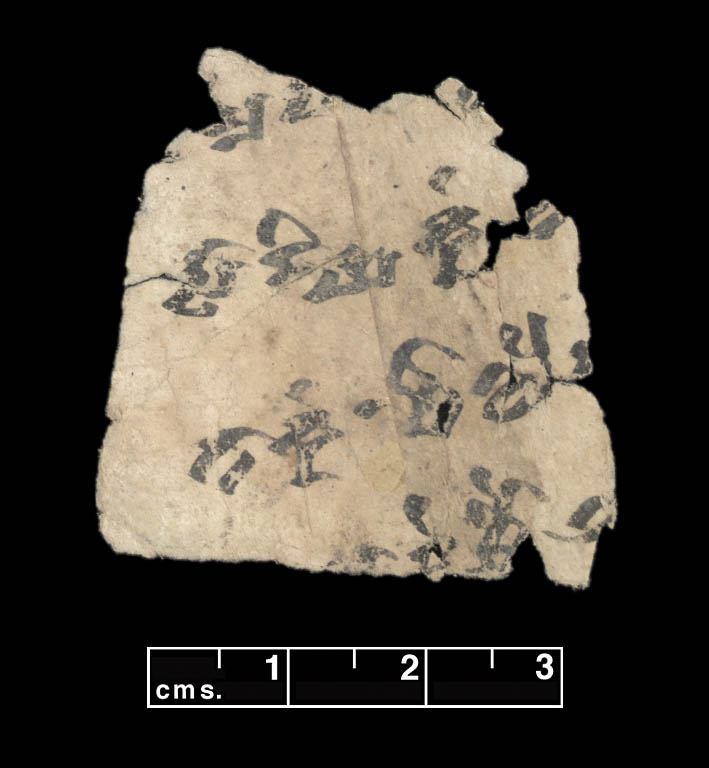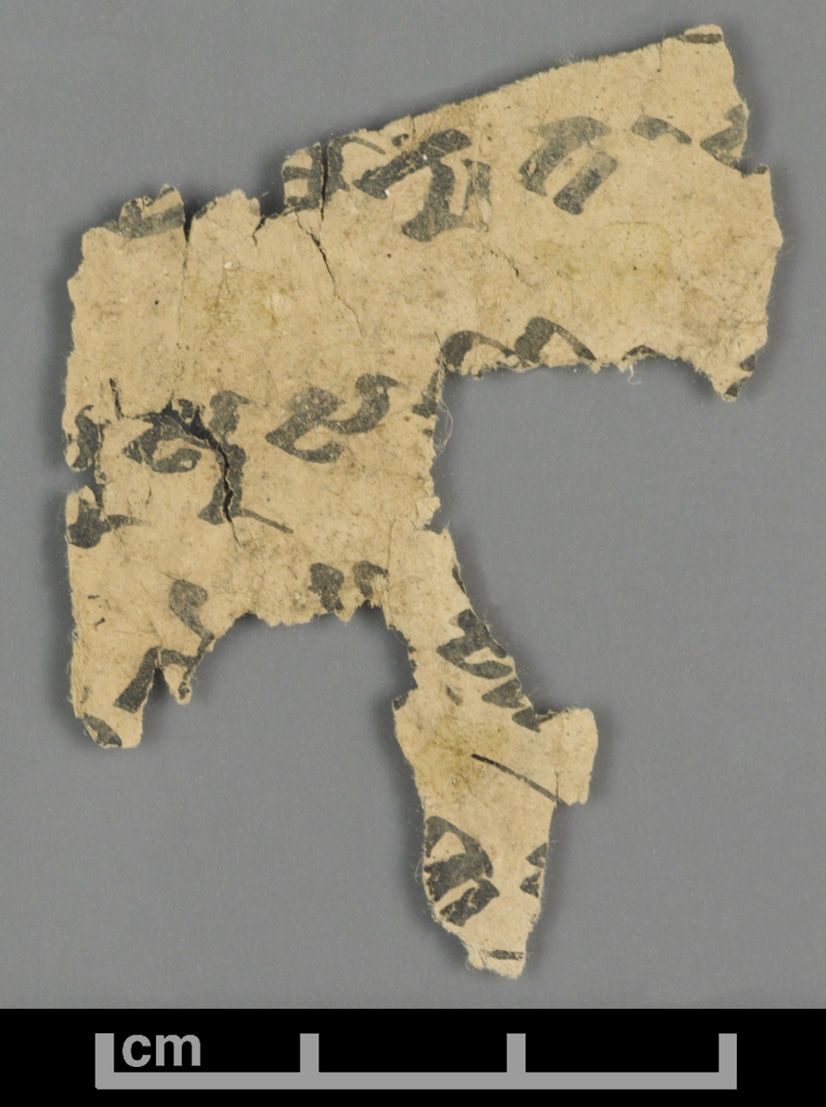IOL Toch 579
| Known as: | IOL Toch 579; 156.Ta.5; IOL Toch 1187 |
|---|---|
| Cite this page as: | Michaël Peyrot. "IOL Toch 579". In A Comprehensive Edition of Tocharian Manuscripts (CEToM). Created and maintained by Melanie Malzahn, Martin Braun, Hannes A. Fellner, and Bernhard Koller. https://cetom.univie.ac.at/?m-ioltoch579 (accessed 02 Jul. 2025). |
Edition | |
| Editor: | Michaël Peyrot |
Provenience | |
| Main find spot: | Unknown |
| Collection: | British Library (London) |
Language and Script | |
| Language: | Skt.; TB |
| Linguistic stage: | classical |
| Script: | classical |
Text contents | |
| Title of the work: | Udānavarga |
| Passage: | 13.7d-13.13c |
| Text genre: | Literary |
| Text subgenre: | Doctrine |
| Verse/Prose: | prose |
Object | |
| Material: | ink on paper |
| Form: | Poṭhī |
| Size (h × w): | 5.4 × 7.3 cm |
| Number of lines: | 5 |
Images
Images from idp.bl.uk by courtesy of the International Dunhuang Project and the British Library.
Transliteration
| a1 | /// m[ā] /// |
|---|---|
| a2 | (–) ·y· [ṣ]· [sp]ṛ [h]· – [bh]a [v]e /// |
| a3 | lsko ñe mā yä nmā s̝s̝aṃ – – – /// |
| a4 | tse • a hi mū [ṣ]a ka d[u] rgaṃ vā • /// |
| a5 | [k]·i • ś[r]ā – – /// |
| b1 | [r]m· [c]· (–) – (– – – – –) – /// |
| b2 | sā ṅghi kaṃ [n]· [v]· [m]· ny· ta • [s]· /// |
| b3 | tā kaṃ • śī le [ṣ]u su sa [m]ā ·i [t]· /// |
| b4 | (–) [s]·[a] [r]e śau l[ś]· [y]e ·ai s[nai] /// |
| b5 | /// ti [jñ]ā /// |
Transcription
| a1 | n1 /// mā /// |
|---|---|
| a2 | n2 (nān)y(e)ṣ(āṃ) spṛh(ako) bhave(t) /// (ompa)¬ |
| a3 | lskoñen3 mā yänmāṣṣäṃ – – – /// |
| a4 | n4 °tse • ahi mūṣakadurgaṃ vā • /// |
| a5 | n5 k(wr)i • śrā(maṇyārtheṣv) /// (ekadha)¬ |
| b1 | rm(aṃ)n6 c(a) – – – – – – – – /// |
| b2 | n7 sāṅghikaṃ n(ā)v(a)m(a)ny(e)ta • s· /// |
| b3 | n8n9 tākaṃ • śīleṣu susamā(h)it(aḥ) /// |
| b4 | n10n11n12 (a)s(t)are śaul ś(a)ye(ñc)ai snai /// |
| b5 | n13 /// (i)ti jñā(tvā) /// |
Translation
| a1 | ... |
|---|---|
| a2 | [SKT] (one should not be) envious towards others |
| a3 | [TB] he does not attain concentration |
| a4 | [TB] (attentive to the duties of monkhood) [SKT] like a snake [to] the mouse hole |
| a5 | [TB] if (one searched for a happy life) [SKT] (attentive to the duties) of monkhood |
| b1 | [SKT] and (one should practise) the only law |
| b2 | [SKT] one should not despise [the garment and the food and drink] of the monks |
| b3 | [TB] if someone (knows little) [SKT] [but] is practising the morale |
| b4 | [TB] [who] lives a pure life and is in(defatigable) |
| b5 | [SKT] (thinking) that he knows little |
Other
| b3 | if he is [someone who] knows little (Peyrot 2013b: 323) |
|---|
Commentary
Parallel texts
| Bernhard 1965: 202-204; Chakravarti 1930: 157-160; Hahn 2007: 51 |
Remarks
| Although the fragments IOL Toch 579 (left, original size w: 3,9 cm, h: 4,4 cm) and IOL Toch 1187 (right, original size w: 3,6 cm, h: 4,4 cm) were edited separately in Peyrot 2008a: 100-102, they clearly belong together. There are no lines missing between a5 and b1, even though the lower margin of the recto (upper of the verso) is not itself preserved. The blank space to the left is probably not the string hole space (pace Peyrot 2008a: 100) because it seems to cover also line a5, which is the last; therefore, the left margin must be preserved. Still, the leaf number is not preserved: perhaps it stood left of lines b4-5. |
Philological commentary
| n1 | m[ā]: The reading is not certain. It could also be rme of Uv.13.7d dharmeṇa na vaṇik caret. If it is really mā, it may be TB mā 'not', rendering Skt. na of the same line. The TB translation may have been pelaiknesa mā karyor yāmi. |
|---|---|
| n2 | Uv.13.8b nānyeṣāṃ spṛhako bhavet. The akṣara spṛ is difficult to read because a tiny piece is flipped over from the verso, see the comment to line b4. |
| n3 | Uv.13.8d samādhiṃ nādhigacchati. The following traces, illegible by themselves, must be [8] (s)[ukh](aṃ), the beginning of Uv.13.9a sukhaṃ jīvitum icchec cet. |
| n4 | Uv.13.9b-c śrāmaṇyārtheṣv avekṣavān / ahir mūṣakadurgaṃ vā, here apparently with ahi for ahir, as no r can be read on top of the akṣara mū. |
| n5 | Uv.13.10a-b sukhaṃ jīvitum icchec cec chrāmaṇyārtheṣv avekṣavān |
| n6 | Uv.13.10d ekadharmaṃ ca bhāvayet |
| n7 | Uv.13.11c sāṃghikaṃ nāvamanyeta. The following [s]· is the beginning of the TB translation of sāṃghikaṃ, possibly saṅkaṣṣe v.s. |
| n8 | Uv.13.12a-b alpajñāto ’pi ced bhavati śīleṣu susamāhitaḥ |
| n9 | śīle[ṣ]u: the ś is closed at the bottom and looks a bit like s. |
| n10 | Uv.13.12d śuddhājīvam atandritam |
| n11 | (a)s(t)are śaul: THT 31 a5 reads āstreṃ śaul, a verse variant of regular prose astare. |
| n12 | śaul [ś]·[y]e·ai: the reading l [ś]· is problematic because the ś seems to be attached directly below the l. If śaul śayeñcai was written together, one would at all times expect an akṣara lśa, not lśa. Probably, the scribe mixed up the two possible spellings lśa in one akṣara and l\ śa in two akṣaras. The ś is partly readable in the reconstructed image, but part of it was flipped over to the recto (see the comment to line a2) on the original image. |
| n13 | Uv.13.13c alpajñātam iti jñātvā |
References
Online access
IDP: IOL Toch 579, IOL Toch 1187
Edition
Peyrot 2007: №579; Tamai 2007: №1187; Peyrot 2008a: 100-102
Translations
Peyrot 2013b: b3 (323)
Bibliography
Bernhard, Franz. 1965. Udānavarga. Band I, Einleitung, Beschreibung der Handschriften, Textausgabe, Bibliographie. Sanskrittexte aus den Turfanfunden 10. Göttingen: Vandenhoeck und Ruprecht.
Chakravarti, Niranjan Prasad. 1930. L‘Udānavarga sanskrit, Texte sanscrit en transcription, avec traduction et annotations, suivi d‘une étude critique et de planches. Tome premier (Chapitres I à XXI). Paris: Geuthner.
Hahn, Michael. 2007. Vom rechten Leben, Buddhistische Lehren aus Indien und Tibet, Aus dem Sanskrit und aus dem Tibetischen übersetzt und herausgegeben. Frankfurt am Main/Leipzig: Verlag der Weltreligionen (im Insel Verlag).
“The International Dunhuang Project: The Silk Road Online.” n.d. http://idp.bl.uk.
Peyrot, Michaël. 2007. “An edition of the Tocharian fragments IOL Toch 1 – IOL Toch 822 in the India Office Library.” International Dunhuang Project. 2007. http://idp.bl.uk/database/oo_cat.a4d?shortref=Peyrot_2007.
Peyrot, Michaël. 2008a. “More Sanskrit – Tocharian B bilingual Udānavarga fragments.” Indogermanische Forschungen 113: 83–125.
Peyrot, Michaël. 2013b. The Tocharian subjunctive. A study in syntax and verbal stem formation. Vol. 8. Brill’s Studies in Indo-European Languages & Linguistics. Leiden/Boston: Brill.
Tamai, Tatsushi. 2007. “An edition of the Tocharian fragments IOL Toch 853 – IOL Toch 1247 in the India Office Library, London.” The International Dunhuang Project: The Silk Road Online. 2007. http://idp.bl.uk/database/oo_cat.a4d?shortref=Tamai_2007.








